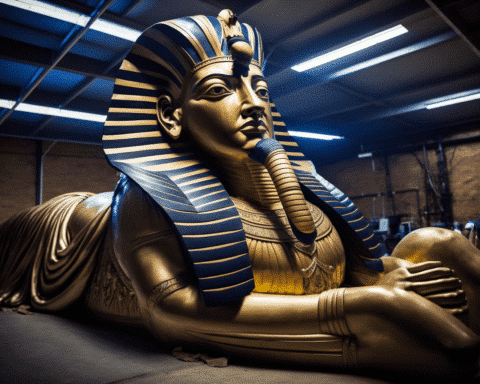From Madagascar to the Moon: Tara Shakti’s Artistic Odyssey
From a young age, award-winning artist Tara Shakti knew she wanted to pursue a career creating paintings that empowered other women. She didn’t predict that her work would one day be launched to the moon as a lasting memorial to human creativity.
A Passion Ignited in Madagascar
Growing up in Madagascar, off the eastern coast of southern Africa, Shakti was raised by a family of artists. Her older brother encouraged her to begin painting with bold colors at just seven years of age. Inspired by the intricacies of Renaissance paintings, she pursued her passion for painting at Accademia d’Arte in Florence, eventually moving to Paris to study the art market at the Drouot Auction House.
Art with a Purpose
Shakti’s work illuminates pressing issues such as human trafficking and systemic oppression. “Growing up and seeing how women are mistreated filled my conscience,” she told CNN. I want to use my art to highlight issues about women. I hope to raise voices and do something to help people.”
The Lunar Codex Project
Shakti is one of 35,000 contemporary artists, writers, poets, podcasters, sculptors, musicians, and filmmakers from across the globe whose work is being sent up to the moon via the Lunar Codex project. The initiative will launch work from 247 countries, Indigenous nations, and territories divided across six time capsules that will be sent to the moon over 18 months. The first successful launch was onboard the Intuitive Machines Odysseus lander via a SpaceX Falcon 9 rocket and it landed in the lunar south pole last February. Another three were successfully launched earlier this year.
A Ride Share with NASA
Canadian physicist, artist, and entrepreneur Dr. Samuel Peralta is self-funding the Lunar Codex. Peralta describes the project as a “message-in-a-bottle archival medium to showcase the beauty of human creativity.” Peralta, chairman of Toronto-based media and technology company Incandence, hopes the project will become a global endeavor to champion underrepresented perspectives. The main criterion for nomination is that artists’ work should have been included in a curated exhibit, collection, anthology, or similar.
Eternalizing Art with Nanofiche
Cultural artifacts are copied onto digital memory cards or inscribed into dime-sized nickel-based Nanofiche, an analogue format that can be read with a microscope and stores up to 150,000 pages of text or photos on a single 8.5 by 11-inch sheet. This high-density storage medium is designed to last billions of years on the moon. The Nanofiche is then sealed and bolted onto the lunar lander before its launch.
“You could think of us as a ride-share with NASA,” said Peralta, explaining that the Astrobotic Griffin lunar lander launching Shakti’s art will carry NASA’s VIPER rover as its main payload, with the Lunar Codex one of several secondary payloads onboard.
Celebrating Achievements
Shakti’s work has already received international recognition. She was honored with the Mosaic 2019 Exposé Award in New York for her series “Archives,” received the Leonardo da Vinci Award in Florence in February 2022, and was awarded the Medal of Recognition from the Embassy of Madagascar later that year.
Peralta invited the artist to submit her work for the project after he discovered her paintings through social media earlier this year. “To have my work launched to the moon is an honor of immeasurable magnitude,” Shakti told CNN in an email. “It is a landmark achievement not only for myself but for the broader Malagasy (Madagascan) art community and reaffirms the significance of my heritage and the stories I strive to share through my art.”
Representing Madagascar on a Global Stage
Among Shakti’s selected paintings is a large-format work titled “The Keepers of the Lost Wisdom,” which depicts the knowledge and strength passed down through generations of Malagasy women. Also going to the moon will be her painting titled “La Reine” (The Queen, in English), which she says emphasizes the complexities and beauty of the feminine experience. Another piece, “Astrochelys Radiata,” highlights Madagascar’s unique biodiversity.
“While living and working in Paris, Tara Shakti’s incorporation of traditional Malagasy themes in modernist compositions establish a unique voice in contemporary art archived in the Lunar Codex collection,” said Peralta.
Although Shakti is currently the only confirmed Malagasy artist whose work will be featured, Peralta encourages artists from Madagascar and elsewhere to submit their portfolios for review and possible inclusion, free of charge.
Inspiring Future Generations
Other artists whose work has already been launched as part of the Lunar Codex project include Ada Limón, the current U.S. poet laureate, who wrote a poem for NASA’s Europa Clipper spacecraft bound for Jupiter in October, and Didi Mendez, a Cuban American artist, and curator whose work was included in the successful February launch.
“The real power of the Lunar project is to inspire artists of today. If they’re toiling in obscurity and wondering whether their work will amount to anything, now they can be sure of their work’s immortality,” Peralta said. “After all, why are we making art if not to leave it for the future, to have a part of ourselves that will last even after we’re done?”




